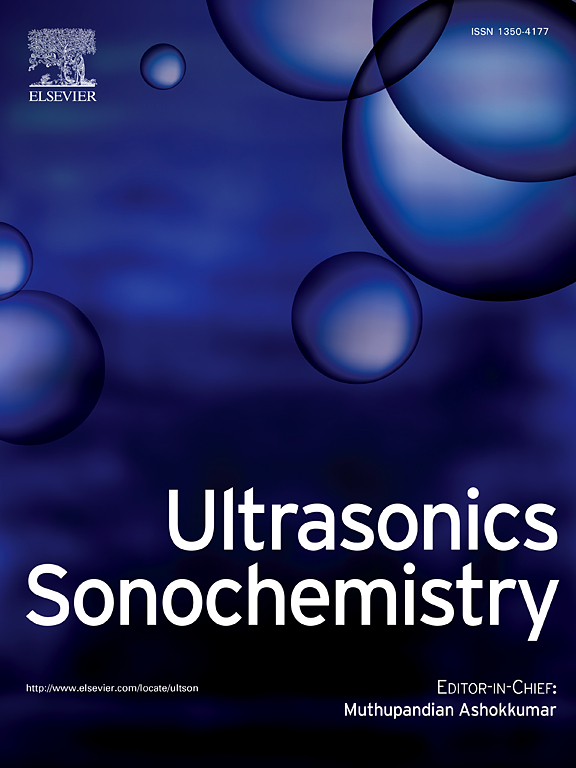利用谷胱甘肽和对苯二甲酸指标探讨超声诱导的自由基形成:水和酸樱桃汁的比较研究。
IF 8.7
1区 化学
Q1 ACOUSTICS
引用次数: 0
摘要
本研究旨在评估超声波在水和酸樱桃汁(SCJ)模型系统中产生自由基(FR)的潜力,采用间接方法,包括谷胱甘肽(GSH),一种众所周知的抗氧化剂,和对苯二甲酸(TPA),氧化时会发出荧光。最初,用不同直径的探针(13毫米和19毫米)对谷胱甘肽水溶液进行不同振幅(60%和80%)的超声检测,检测时间长达30分钟,以确定最大氧化条件。采用配备二极管阵列检测器的UPLC和GSH和TPA氧化荧光分光光度计分别监测FR的形成。延长超声时间可降低两种探针水中的谷胱甘肽含量,增加氧化谷胱甘肽含量;然而,19毫米探针产生的GSSG是13毫米探针的5倍,这意味着FR的形成率要高得多。随后,在30分钟内,用19毫米探针对含水TPA溶液(代表更具有挑战性的条件)以先前优化的振幅(67%)施加超声。随着时间的推移,水样显示TPA荧光强度随着超声持续时间的延长而稳步增加,这表明FRs驱动的氧化反应在水中随着时间的推移而进行。在相同条件下对添加GSH-和tpa的SCJ进行超声处理后,LC-QTOF-MS和荧光分光光度法分析显示,没有GSSG或荧光形成,证实这两种指标都没有明显的氧化,可能是由于果汁的复杂成分(例如,抗氧化化合物的存在)。这项研究为超声条件如何通过将FR稳定在可检测的形式来影响水和SCJ介质中的FR形成提供了关键的见解。本文章由计算机程序翻译,如有差异,请以英文原文为准。

Exploring ultrasound-induced free radical formation: A comparative study in water and sour cherry juice using glutathione and terephthalic acid indicators
This study aims to assess free radical (FR) generation potential of ultrasound in water and sour cherry juice (SCJ) model systems using an indirect method with specific indicators including glutathione (GSH), a well-known antioxidant, and terephthalic acid (TPA), which fluoresces upon oxidation. Initially, aqueous GSH solutions were subjected to ultrasound at varying amplitudes (60 % and 80 %) for up to 30 min using probes of different diameters (13 mm and 19 mm) to identify maximal oxidation conditions. FR formation was monitored using UPLC equipped with diode array detector and fluorescence spectrophotometer for GSH and TPA oxidation, respectively. Increasing sonication time decreased GSH and increased oxidized glutathione (GSSG) in water for both probes; however, the 19 mm probe generated five times more GSSG than the 13 mm, implying a substantially higher rate of FR formation. Subsequently, ultrasound was applied to aqueous TPA solution using the 19 mm probe—representing the more challenging conditions—at a previously optimized amplitude (67 %) during 30 min. Time-course water samples showed a steady increase in TPA fluorescence intensity with longer sonication durations, suggesting that oxidation reactions driven by FRs were progressing over time in water. Following sonication of GSH- and TPA-added SCJ under the same conditions, analysis by LC-QTOF-MS and fluorescence spectrophotometry revealed no GSSG or fluorescence formation, confirming the absence of notable oxidation of both indicators, likely due to the juice’s complex composition (e.g., presence of antioxidant compounds). This study offers key insights into how ultrasound conditions affect FR formation in water and SCJ media by stabilizing them in detectable forms.
求助全文
通过发布文献求助,成功后即可免费获取论文全文。
去求助
来源期刊

Ultrasonics Sonochemistry
化学-化学综合
CiteScore
15.80
自引率
11.90%
发文量
361
审稿时长
59 days
期刊介绍:
Ultrasonics Sonochemistry stands as a premier international journal dedicated to the publication of high-quality research articles primarily focusing on chemical reactions and reactors induced by ultrasonic waves, known as sonochemistry. Beyond chemical reactions, the journal also welcomes contributions related to cavitation-induced events and processing, including sonoluminescence, and the transformation of materials on chemical, physical, and biological levels.
Since its inception in 1994, Ultrasonics Sonochemistry has consistently maintained a top ranking in the "Acoustics" category, reflecting its esteemed reputation in the field. The journal publishes exceptional papers covering various areas of ultrasonics and sonochemistry. Its contributions are highly regarded by both academia and industry stakeholders, demonstrating its relevance and impact in advancing research and innovation.
 求助内容:
求助内容: 应助结果提醒方式:
应助结果提醒方式:


